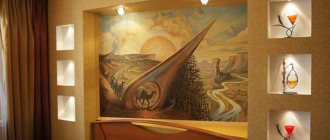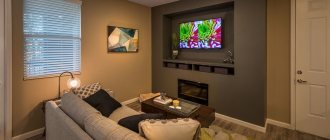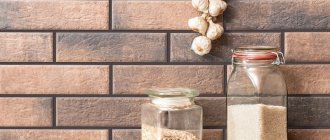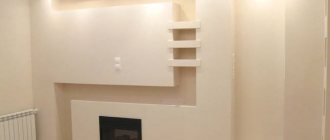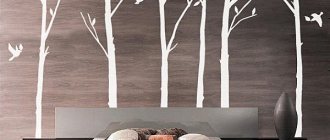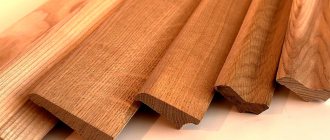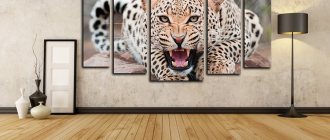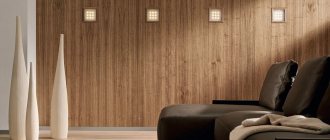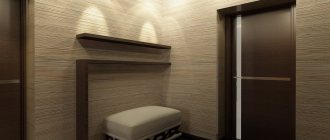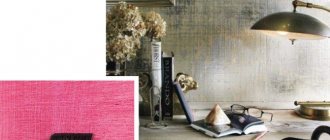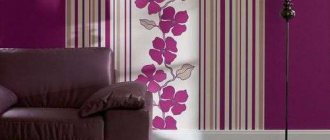Recommendations for niche design
A few top tips:
- When arranging a niche, you should take into account its use and the purpose of the room in which it will be located.
- When choosing the shape and size of a wall structure, it is important to pay attention to the dimensions of the room.
- The external decoration of the recess should be harmoniously combined with the overall interior.
- It is not advisable to use too dark colors to decorate the alcove.
- It is not recommended to clutter this structure with a large amount of decor.
Creating a project and marking the surface
Take a sheet of paper and sketch out the shape of the future niche on it. Consider the weight that the plasterboard niche will need to support. It’s one thing when a niche is created to place essential items on it, and another when it’s planned to store bags, jars, canned goods on it, in general, to use it for long-term storage of heavy things. This item will be needed when creating the frame; for the second option it will have to be made more durable. If you have experience using graphic editors, then it is better to make a product project there.
Also, to do the job well, you need to make an estimate and a list of necessary tools. To create an estimate, you will need to calculate the number of profiles. You can read about what tools you need to use to work with drywall in this article.
When you know exactly the shape of the niche, its location and dimensions, you can begin marking. When marking, you need to take into account the objects that are planned to be placed in the niche, most often these are ordinary things, such as various bottles, candles, books, figurines, etc., but also, quite often, plasma panels are placed in niches. In addition, you can make a niche not in the wall, but in its corner, but corner niches will not withstand a lot of weight, this must be remembered. A niche created taking into account the size of the radiator is also ideal for the battery radiator.
At the marking stage, you need to mark the location of the guide profiles; this should be done using a level, so the frame will be level. Check the wall for bumps and depressions to avoid future problems with mismatched dimensions of the plasterboard niches. After marking the surface, you can begin to build the frame.
Types of niches in the wall
There are several varieties:
- Functional. They differ not only in their decorative functions, but also become a real tool in creating a convenient and thoughtful design, which is especially important in rooms with a small area.
- Decorative. They become an excellent corrective element when it is necessary to hide some planning flaws.
These recesses undoubtedly give the interior of the room additional coziness and comfort. They can simply decorate the environment or perform a specific function, for example, you can equip a niche even instead of a window, thereby creating a cozy corner for relaxing or reading.
Niche for large items
In addition to decorative ones, there are also functional ones, which are made specifically to accommodate various large items of equipment or furniture. They can accommodate a TV, stereo system, washing machine and furniture.
A chest of drawers, a sofa, a wardrobe, or a shelving unit placed in a niche allows you to save a lot of free space in the room and brings order to the interior. Particularly popular are cabinets built into the wall, which save as much space as possible. Household appliances placed in a niche, for example, a washing machine or refrigerator, will be practically invisible.
Small recesses can serve as a bookcase or shelves for dishes. Decorative niches are usually located in the most noticeable places where the eye lingers. The great advantage of such recesses is that you can often modify them by repainting, gluing, sheathing and adding various elements.
Options for decorative finishing of a niche
Popular finishing materials used for decoration.
Wallpaper
They are an excellent solution that allows you to approach decoration creatively, give the room an elegant and fashionable look and add modern notes to it or, conversely, a light vintage touch.
The photo shows the bedroom interior and a wall with a niche decorated with blue patterned wallpaper.
Tile
With the help of such finishing, you can create a bright or calm design, create a certain mood in the interior and place elegant accents.
Decorative plaster
It makes the appearance of the niche more aesthetic and elegant, significantly enlivens the atmosphere and gives the room a certain character.
Design with decorative stone or brick
This finishing option, due to its naturalness, will undoubtedly become the center of the entire interior composition and an original design solution that will attract attention.
The photo shows a wall and a niche with a TV, lined with white brick in the kitchen interior.
Laminate
Thanks to the huge variety of colors and shades, high quality, durability, environmental friendliness and safety, laminate allows you to create not only an original, but also a very practical design.
Tree
High-quality and environmentally friendly materials such as lining or wood panels provide an excellent opportunity to imbue the atmosphere with the mood of wildlife.
How to beautifully design a niche?
The most popular design techniques.
Mirror
A classic option for decorating a niche in the wall, which allows you not only to bring originality to the atmosphere, but also to effectively organize the space. In addition, thanks to the mirror surface, it is possible to create the illusion of expanding the dimensions of the room.
painting
The recesses, decorated with realistic and delicately drawn, amazingly beautiful designs, acquire a more elegant, airy and at the same time luxurious appearance.
In the photo there is a niche at the head of the bed, decorated with paintings in the form of floral designs.
Niche with shelves
This design in the wall makes it easy to fill it with various photographs, vases, books, indoor flowers or any other trinkets. With the help of competent display design of a niche, you can give the atmosphere even more comfort and attractiveness.
Stained glass
Stained glass panels are perfect for decorating recesses in the wall. In addition, with well-organized lighting, a stained glass window can turn into an interesting night light or simply become an accent element of the entire room.
Paintings and frescoes
It is quite a relevant and fashionable solution, which always favorably emphasizes the structure in the wall and makes it a chic art object in the room.
Edging
Beautifully emphasizes, highlights the shape of the recess, makes its corners more neat and gives completeness and integrity.
Illumination in a niche
With the help of various lighting, the recesses acquire a non-trivial, slightly mysterious and enigmatic appearance.
The photo shows a large bedside niche in the wall, equipped with spotlights in the bedroom interior.
Master class: DIY niche frame
There is no point in inserting any cabinet or shelves into a very narrow niche; they simply won’t fit there. The options for covering the back wall are also narrowing; it should be thin so as not to narrow the already shallow niche. Therefore, in this case, paint or wallpaper is used.
BEFORE PHOTO (niche before processing:)
This niche had already been covered with structured wallpaper; the only question that remained was how else it could be refined. And the frame is a wonderful way out of the situation .
Since the door frame and baseboards are made in the same style and painted white, the decision to make the frame for the niche the same came naturally.
AFTER (Niche after treatment):
Necessary materials:
- 2 boards 9 cm wide and 114 cm long (for the inner sides of the frame)
- 2 boards 9 cm wide and 117 cm long (for the outer side parts of the frame)
- 2 boards 9 cm wide and 97 cm long (for the inner top and bottom of the frame)
- 2 boards 13 cm wide and 112 cm long (for the outer top and bottom parts of the frame)
- Wood glue
- Hidden dowels
- Screws
- Drill
- Sandpaper
- Paint and brush
Pine boards were used here.
Make the measurements based on the size of the niche in your apartment.
- The outer side boards and the inner top and bottom boards must be exactly the size of the niche;
- the inner side boards must be smaller than the size of the niche by the width of the boards so that the folded frame fits into the niche.
Where is it usually located?
Several accommodation options:
- Under the window. Most often, this arrangement is used to disguise and play up an unsightly heating radiator or to organize the necessary storage system.
- Corner. With the help of a corner structure in the wall, you can adjust the visual perception of space, giving it liveliness and at the same time practicality.
- In a false wall. This placement allows you to effectively diversify the design of the room and give it individuality.
- Above the sofa. Non-through openings of rectangular or square shape located above the sofa favorably emphasize the geometric nature of the room and give it discipline.
Various options for symmetrical or asymmetrical placement allow you to diversify a standard and boring interior and add dynamics and some liveliness to it.
The photo shows a bedroom with decorative niches placed in the partition.
Dimensions and shapes of niches
There are several varieties.
Semicircular
Thanks to such spectacular arched structures, it is possible to decorate any setting and advantageously emphasize the interior beauty.
Rectangular shape
They add uniqueness and sophistication to the design, and also visually change the spatial perception of the room, depriving it of boring and monotony.
Full wall
A recess in the entire wall, decorated with light elements, will significantly transform the surface of the walls and, even with a small depth, will look very impressive and profitable.
Narrow
Narrow niches located above a bed or sofa not only decorate the wall, but also provide an excellent opportunity to place various photographs, books, figurines or other accessories in it.
The photo shows a horizontal narrow niche located in the wall at the head of the bed.
Curly
Designs with curved or smooth lines undoubtedly become the decoration of any space, giving it interest and uniqueness.
The photo shows a nursery for a girl with a white wall decorated with curly niches in a light green color.
Through
Openings with a through design must have an impeccable and uniform design, since this design is clearly visible from both sides.
How to do it?
How can you create a niche if it was not included in the plan during the construction of the building? At first glance, the task is difficult: you cannot dismantle part of the wall just for the sake of beauty, and its thickness is unlikely to allow this to be done without consequences. In addition, it is expensive and energy-consuming, regardless of whether you do it yourself or turn to specialists.
Fortunately, there are several ideas and instructions on how to make a niche. The easiest way is to use a plasterboard wall. It can fit close to a real wall, or it can act as a partition. One or more niches of any size and shape are cut into it. In this way you can make, for example, an entire bookcase.
First, the frame is attached and then covered with plasterboard boards. Disadvantage: It takes up extra space, but does not perform many of the functions of a regular wall.
Design ideas in various styles
Blind openings easily fit into the concept of various style trends, such as Provence, loft, hi-tech, modern, classic style and many others.
The photo shows a classic-style bedroom and a wall with a niche for a TV, decorated with stucco.
Niches in the wall can have a certain style-forming character, which allows you to further emphasize the overall appearance of the room.
Place for household appliances
The functional design of a niche helps to significantly save space in the kitchen. The recess accommodates a refrigerator, a shelf with a microwave oven and other appliances that should be at hand.
A niche in a small living room is a great option for a TV.
